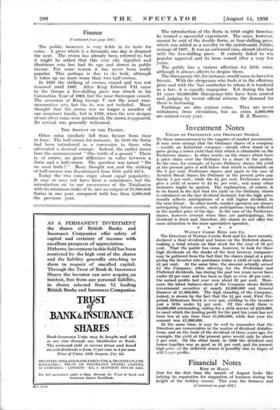Investment Notes
YIELDS ON PREFERENCE AND ORDINARY SHARES.
To those unaccustomed to the vagaries of market movements, it may seem strange that the Ordinary shares of a company —usually an Industrial company—should often stand at a price giving a lower yield than that which is obtainable on the Preference shares ; in other words, on the shares which have a prior claim over the Ordinary to a share in the profits. In the case, for example, of Lyons Ordinary shares, the yield at the present price is well below that which is obtainable on the 8 per cent. Preference shares, and again in the case of Aerated Bread shares the Ordinary at the present price pay barely 4 per cent., while the 64- per cent. Preference shares give a yield of nearer to £4 6s. per cent., and many other instances- might be . quoted, The explanation, of ciotirSe, is to be found in the fact that the yield on the Ordinary shares is calculated on the last dividend declared, but the high price usually reflects anticipations of a still higher dividend in the near future. In other words, market operators are always anticipating future results, such anticipations being reflected in the market price of the day. In the case of the Preference shares, however (except when they are participating), the dividend is fixed and, therefore, the shares do not offer.:the satne attraction to the mere speculative-Operator:
* * * WATNEY COMBE REID AND Co.
The Directors of Watney Combe Reid and Co. have recently ' declared a final dividend and bonus- on the Deferred shares, making a total return on that stock for the year of 18, per cent. That the public has come, however, to look for these high dividends on the stocks of the best brewery companies may be gathered from the fact that the shares stand at a price giving the investor who purchases today ayield of only about 4f per cent. At the same time, the amount actually earned : by the Company, after allowing for the Preference' and Preferred dividends, has during the past ten years never been under 22 per cent. and has been as high as over 40 per cent.; the earned profits last year were about 32 per cent. More- over, the latest balance-sheet of. the Company shows British Government securities at nearly £2,000,000 and General Reserve at £1,000,000. The high, standing of the Company, . indeed, is shown by the fact that the 3f per cent. First Per- • .petual Debenture Stock is over par, yielding to the investor just a little under 3f per cent. Of this stock th'ere is £6,000,000 outstanding, calling for a .debt service 't:d agm000, to meet which the trading profit for the past -ten years has not been less at any time than £1,680,000, while last year the amount was £1,998,000.
At the same time, it may be well to remember that the Directors are conservative in the matter of dividend distribu- tions, and on the basis of the dividend of three years ago, for example, the yield at the present price would only be about 3 per cent. On the other hand; in 1980 the dividend. and bonus together was as good as 21 per cent. and the present high price of the deferred shares is-Possibly cluezto hopes of
still larger profits. ,






































 Previous page
Previous page